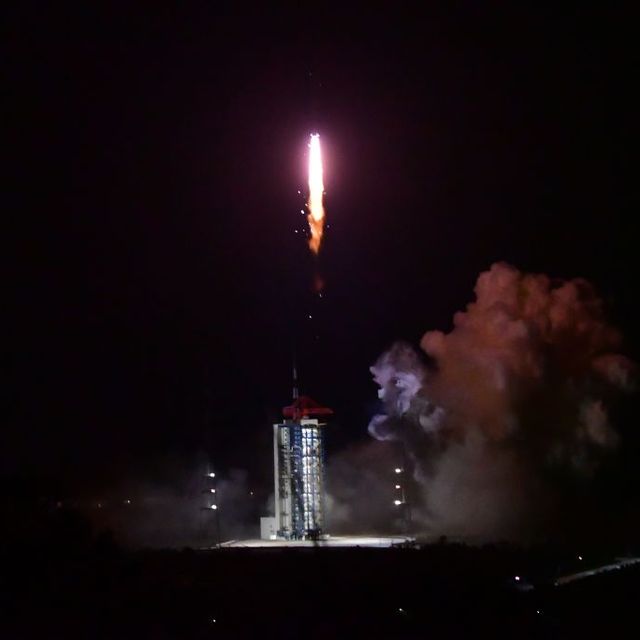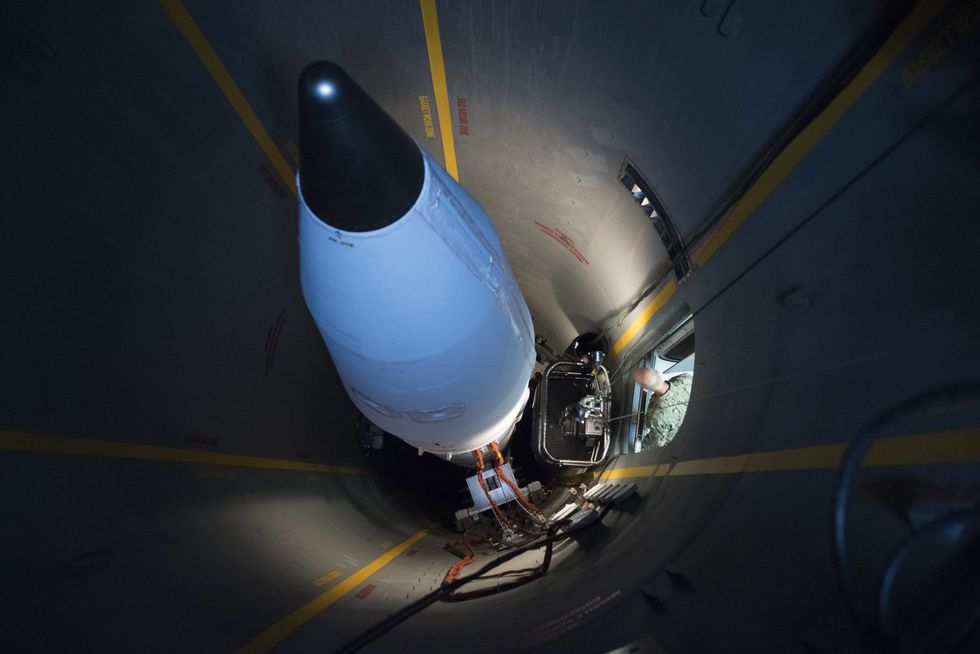- Unnamed U.S. officials have accused China of testing a suborbital nuclear weapon system.
- China denies that the summer rocket launch in question involved a weapon system at all, instead stating that it was a "space vehicle."
- During the Cold War, the Soviet Union developed Fractional Orbital Bombardment Systems (FOBS) to run around U.S. defenses.
China reportedly tested a nuclear delivery system over the summer that is designed to sneak around U.S. defenses—by sending them on a brief trip into Earth's orbit.
Reportedly a Fractional Orbital Bombardment System (FOBS), the nuclear weapon is a thermonuclear device that takes the long way around the planet to catch U.S. early warning radars from the opposite direction. China, for its part, denied the operation involved a weapon at all, instead claiming that it was a test of a new "space vehicle."
✈︎ Don't miss our best-in-class military news. Join our squadron.
A suborbital nuclear weapon is one that enters low-Earth orbit, but descends back into the atmosphere before it completes a full orbit. (The 1967 Outer Space Treaty bans the placement of nukes in orbit, but suborbital flight paths technically don't qualify.) Sending an object into orbit and letting it coast in space is faster and more efficient than burning a rocket engine for the entire trip. Technically, most long-range intercontinental ballistic missiles (ICBMs) are suborbital weapons.
The test in question, as first reported by the Financial Times, took place in August:
Five people familiar with the test said the Chinese military launched a rocket that carried a hypersonic glide vehicle which flew through low-orbit space before cruising down towards its target.
The missile missed its target by about two-dozen miles, according to three people briefed on the intelligence. But two said the test showed that China had made astounding progress on hypersonic weapons and was far more advanced than US officials realised.
China seems to believe that the Financial Times report is actually referring to a July launch of a reusable, suborbital space plane. Even if that holds true, it doesn't mean that China isn't working on tech to get around U.S. missile defenses.
"It's unclear what was tested," Laura Grego—a Stanton Nuclear Security Fellow and member of the Union of Concerned Scientists—tells Popular Mechanics. "However, there is nothing surprising about China seeking technologies to avoid or get through missile defenses, given their smaller nuclear arsenal."
If this launch really did include a Fractional Orbital Bombardment System, it's a throwback to the Cold War that could bypass early warning radars that countries like the U.S. use to track ballistic missiles.
Most nuclear-tipped intercontinental ballistic missiles have a northern trajectory. The United States, Russia, China, and most other nuclear powers are located in the Northern Hemisphere. The shortest, most direct means for each nation to attack one another is over the Arctic Circle. For that reason, ICBMs launch north and descend on their targets from the north. As a result, the U.S., Russia, and China all position their long-range, early warning radars facing northward.
In the 1960s, the Soviet Union first invented Fractional Orbital Bombardment Systems. FOBS consisted of a thermonuclear weapon (mounted on a long-range rocket or missile) and launched on a southern trajectory. The Soviet Union, for example, could fire a FOBS weapon toward the equator and into low-Earth orbit. The weapon would pass over the Antarctic Circle, de-orbit somewhere over South or Central America, and approach the United States from the south, nuking U.S. early warning radars.
If the Soviet Union destroyed those radars, U.S. forces would be effectively blinded, unable to see a first strike by the rest of the enemy's missile force. The Soviets could then launch the rest of their nukes, catching American nuclear forces on the ground. However, the introduction of submarine-launched missiles in the mid-1960s made FOBS obsolete: even if bombers and ICBMs were destroyed by a surprise attack, submarines hidden at sea could still launch devastating retaliatory strikes.
Despite the invention of submarine-launched nukes, the Soviet Union still deployed 18 R-36-O missiles with FOBS warheads, beginning in 1969. The weapons, as missile defense and arms control expert Jeffrey Lewis explains on Twitter, were meant to counter the U.S. Safeguard missile defense system. Safeguard was designed to use Spartan and Sprint missiles to shoot down Soviet warheads targeting U.S. ICBMs. The Soviet Union would use FOBS to target the system's radar network from the rear, rendering the ICBMs vulnerable again.
The U.S. government canceled Safeguard in 1975, and the Soviet Union retired its FOBS weapons in 1983. Since then, none of the world's nuclear powers have considered FOBS useful enough to field an operational system.
In September, incoming Secretary of the Air Force Frank Kendall made an oblique reference to a Chinese FOBS system, describing Chinese advances in missile and space technology. He specifically mentioned the FOBS concept—though he did not actually come out and say definitively that China conducted a test.
Why would China develop a FOBS system now? The U.S. government maintains a force of 44 Ground-Based Midcourse Defense (GMD) interceptors. The missiles, stationed in Alaska and California, are designed to protect the homeland from limited missile attacks from "rogue" nuclear threats like Iran and North Korea. GMD is not designed to provide a defense against far more numerous Chinese and Russian nukes.
Russia and China, however, are not convinced. Both countries consider nuclear weapons their ultimate means of defense. Both are concerned that the U.S. could scale up the GMD program, buying additional interceptors and tying in guided-missile destroyers armed with seagoing SM-3 Block 1B missiles. Such a system, scaled several times over, could once again protect ICBMs or blunt a Chinese or Russian attack.
Russia has warned for years that U.S. missile defense efforts threatened the effectiveness of the country's nuclear deterrent. In 2018, Russia introduced a number of new nuclear systems designed to work around missile defense. Poseidon, a long-range nuclear torpedo designed to destroy U.S. ports and coastal cities, swims around missile defenses. Avangard, a hypersonic weapon mated to an ICBM, is meant to fly under missile defense radars and knock them out with a thermonuclear punch. The RS-28 Sarmat is a super-heavy ICBM that carries up to 15 warheads and dummy warheads, boosting the number of incoming threats a missile defense system must deal with.
The new FOBS test could be part of China's efforts to develop similar weapons. Even if that's true, it doesn't mean China intends to attack, but it does mean it considers U.S. defense efforts a threat to their nuclear deterrent.
"The U.S. missile defense system as it stands has little capability against Chinese intercontinental range missiles, and given China's experiments with missile defense they should understand this," Grego says. "However, China might decide to hedge against future improvements, given the U.S. continues to invest many billions of dollars per year in these programs."
If China does deploy a FOBS system, it changes little for the security of the United States. After all, the missile defense system was not developed with China in mind. Nuclear deterrence still means any state foolish enough to launch a surprise attack on the U.S. would commit national suicide. The test is more about China's insecurity in the face of American missile defense—and Beijing's determination not to allow the United States to become invulnerable to Chinese nuclear retaliation.
🎥 Now Watch This:

Kyle Mizokami is a writer on defense and security issues and has been at Popular Mechanics since 2015. If it involves explosions or projectiles, he's generally in favor of it. Kyle’s articles have appeared at The Daily Beast, U.S. Naval Institute News, The Diplomat, Foreign Policy, Combat Aircraft Monthly, VICE News, and others. He lives in San Francisco.
















